



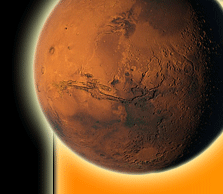


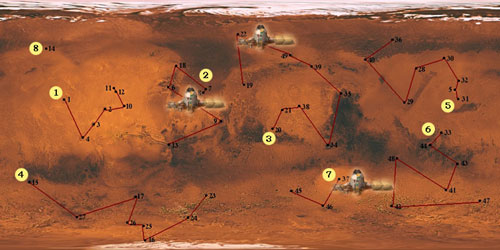
Tours
The risky conditions require compulsory insurance, which is obligatory for everyone. Of course the touring service undertakes different safety measures as stable, strong and in working order base, life-conditioning space suits etc. We suggest you eight generall directions:
First suggestion - Around The Tharsis Volcanoes:
This is the most expensive tour because of the visitation of the famous Tharsis Mons. Every station is close to the others, which makes the travel between them short and comfortable. The route is : Uranius Tholus - Ceraunius Tholus - Tharsis Tholus - Ascraeus Mons - Pavonis Mons - Arsia Mons - Olympus Mons. The path is also the most extreme and dangerous on the red planet. It is not for all kinds of people, so the tourist should be very certain of his choice, especially if it is this one. The tours lasts two weeks and includes climbing of some summits (at the visitor's will), as well observing the hirozon and the geological past of the volcanoes.
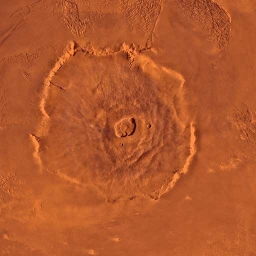 OLYMPUS MONS
OLYMPUS MONS
Olympus Mons is the largest volcano not only in the Tharsis Montes region, but also in the whole solar system. It is a shield volcano 624 km in diameter (approximately the same size as the state of Arizona), 25 km high (3 times higher than Everest), and is rimmed by a 6 km high scarp. A caldera 80 km wide is located at the summit of Olympus Mons. The volume of Olympus Mons is about 100 times larger than that of Mauna Loa - the largest volcano on Earth, which is 10 km high and 120 km across. Actually, the entire chain of Hawaiian islands would fit inside Olympus Mons.
Another reason why the volcanoes on Mars are so massive is because the crust on Mars doesn't move the way it does on Earth. On Earth, the hot spots remain stationary but crustal plates are moving above them. The Hawaiian islands result from the northwesterly movement of the Pacific plate over a stationary hotspot producing lava. As the plate moves over the hotspot, new volcanoes are formed and the existing ones become extinct. This distributes the total volume of lava among many volcanoes rather than one large volcano. On Mars, the crust remains stationary and the lava piles up in one, very large volcano.
THARSIS THOLUS The name "tholus" means "dome". Tharsis Tholus lies just to the north of the three Tharsis Montes. The volcano is the smallest of all the Tharsis volcanoes. Although it is small compared to other Martian volcanoes, its volume would be very large if it were on Earth - Tharsis Tholus is about 170 km in diameter and 8 km high (the same size as Mauna Loa). The relative age of a planetary surface can be understood from us thanks to the crater-count analyses - Tharsis Tholus appears to have been dormant for the past 2 billion years. The caldera has a wide bench round one side, which may represent an early lava lake level before further collapse occurred in the middle of the caldera. Scarps intersecting the caldera appear to be normal faults rather than graben. The volcano is partially buried. Its base is covered by younger materials.
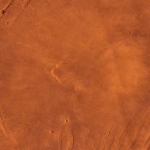 ALBA PATERA
ALBA PATERAAlba Patera is a unique volcanic feature to the north of the Tharsis region of Mars. This enormous shield volcano is 1600 kilometers across but only about 3 kilometers tall at its highest point. It has thinner lava flows than other Martian shield volcanos, with both enormous sheet-like layers and hundreds of long, narrow channels on its flanks. Most of the narrow channels are over 100 kilometers long, with some over 300 kilometers, suggesting very fluid lava erupting over long periods of time. Alba Patera is located on a system of faults running northwards from Tharsis. Alba differs from the other Martian paterae in several ways, lacking furrowed ash deposits and being located in lowlands rather than highlands.
Ceraunius Tholus - a "small" volcano in the Tharsis Bulge just north of the three large Tharsis volcanos described above. Ceraunius is about 21000 feet high; the crater at the summit is about 15 miles across. The true base of the volcano is submerged in the flood of lava which produced the surrounding Tharsis plain. Gigantic stress fractures caused by the upwelling of magma from below cross this region.
Second suggestion - From Wahoo To The Deep Depressions Of Valles Marineris:
After landing in Wahoo and a short adapting with the conditions on the Martian surface the tourists are ready for the next step - visitation of the crater Kipini and two northern craters. The path continues with the broken terrain Aram Chaos and ends with one of the most eastern points of Valles Marineris - the deep depression Coprates Chasma. The tour lasts 5 days and is the best for everyone, who has never been on Mars before. The route is quite simple: Wahoo - Kipini - Sytinskaya - Sharonov - Aram Chaos - Coprates Chasma.
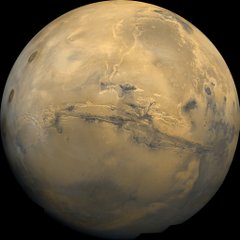 VALLES MARINERIS
VALLES MARINERISValles Marineris (Mariner Valley) is a vast canyon system that runs along the Martian equator just east of the Tharsis region. The great canyon system of Valles Marineris stretches 4000 kilometers across Mars and reaches depths of up to 7 km. The individual canyons can be as wide as 200 kilometers. Compared with the Mariner Valley the Grand Canyon in Arizona is about *800/450* km long, 30 kilometers wide, and 1.6 km deep. In fact, the length of Valles Marineris is approximately the length of the United States and it spans about 20% of the entire Martian equator. The canyon system extends from the Noctis Labyrinthus region in the west to the chaotic terrain in the east. Most researchers agree that Valles Marineris is a large tectonic "crack" in the Martian crust, which formed as the planet cooled, affecting by the rising crust in the Tharsis region to the west and subsequently widening by erosional forces.
Third suggestion - The North Polar Hood:
The longest route, suggested now on Mars, which contains visiting of nine of the nordest craters and a direct flight to the North Polar Cap (for one day). The tour lasts two weeks because of the big number of stations that must be visited. The route is : Schiaparelli - Henry - Tikhonravov - Huygens - Baldet - Moreux - Lyot - Lomonosov - Curie. This suggestion is only for the greatest fans of the red planet.
Forth suggestion - The South Polar Cap:
The visitation of the SPC begins with the famous crater Newton. It reaches Lomela - southern crater, where the mean tempratures are up to -100 degrees C. Here the tourists can find frozen CO2 or "dry ice". There are different kinds of occupations here, but the risk of freezing caused by fault in the space suit or the base equipment is closely watched by the local supporting service. The route is : Newton - Chamberlin - Lowell - Agassiz - Schmidt - Lomela - Phillips - Galle. After Lomela the path goes north to the craters Phillips and Galle, where the tourist can recruit their health and strength.
Fifth suggestion - Elysium and Utopia Planitia:
One of the longest directions on Mars. Two very famous and researched objects are included in this tour - Elysium Planitia and the smaller Utopia Planitia. The route is : Cydnus Rupes - Utopia Planitia - Xui - Kufra - Mie - Trebia Valles - Elysium Rupes - Albor Tholus. The volcanoes of Elysium are lower than the those on the Tharsis region and the craters and the valley are smaller than many others. This makes the price acceptable for more tourists, who can see much and different kinds of objects on Mars. The route is perfect for the ordianry tourist.
Sixth suggestion - The Winds Of Gale:
The route is : Gale - Herschel - Molesworth - Kepler - Piyi - Secchi - Campbell. The most interesting object from this direction is the crater Gale that is famous with the equipment for the high-speed Martian winds - some reaching 400km/h (in the Martian spring when the dry ice melts). Its name comes from the moment of its discovering when a gale was on the same place. The opportunity to test the strength of the powerful winds and sandstorms is liked by a lot of tourists, generally because of its dangers and rarity. But this event depends too much on the weather conditions and is not always available. Of course the other stations are not less exciting than the crater Gale.
Seventh suggestion - The Hellas Basin:
The cheapest direction with traveling, also recommended by the guides. The stations are three as the final stop is Hellas Planitia. The Hellas impact basin is the largest on Mars. It is 1300 miles across and over 29,000 feet deep (enough to accommodate Everest) and surrounded by a huge volume of excavated material. The tour lasts up to five days. The route is : Proctor - Paneus Patera - Hellas Planitia.
Eighth suggestion - Troubled Rest In The Milancovic Crater:
The cheapest of all suggested directions. For all people, who don't like travelling. Except the fact that the tourist economizes much money, he can enjoy a restless week on a place named Milankovic. The crater is full of opportunities for sport, researching as well as the Martian surrounding area as the night sky on the planet. Here the short walks are something usual that would give everyone a chance to feel good far from the Earth's life.
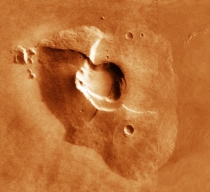 THARSIS MONTES
THARSIS MONTES
Tharsis Montes is the largest volcanic region on Mars. It is approximately 4,000 km across, 10 km high, and contains 12 large volcanoes. The largest of them in the Tharsis region are 4 shield volcanoes named Ascraeus Mons, Pavonis Mons, Arsia Mons, and Olympus Mons. They are located on the crest of the crustal bulge (a large pile of lava flows) and vary from 350 to 450 kilometers in horizontal extent - each of them rise about 15 kilometers above the surrounding plains. This is still more than half again the height of the Hawaiian volcanoes on Earth. The Tharsis Montes (Ascraeus, Pavonis, and Arsia) are nearly 700 km apart and each reaches nearly the same height as Olympus Mons (~25-27 km) - the largest of the Tharsis volcanoes, but each is somewhat smaller than it. The fractures southeast of Pavonis Mons are named Noctis Labyrinthus - this region merges with the enormous Vallis Marineris canyon system to the east. The three giant shield volcanoes form a line nearly 1500 km long. They seem to have formed together and they were active for a very long time. Now Arsia Mons appears to be slightly older than Pavonis Mons and Ascreus Mons seems to be slightly younger. Therefore, volcanism in the Tharsis region may have slowly shifted north over time. While not the largest of the Tharsis volcanoes, Arsia Mons has the largest caldera on Mars, having a diameter of 120 km. The main difference between the volcanoes on Mars and Earth is their size - volcanoes in the Tharsis region are up to 100 times larger than those anywhere on Earth.
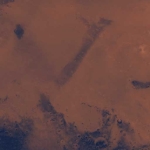 ELYSIUM PLANITIA
ELYSIUM PLANITIAElysium Planitia is the second largest volcanic region on Mars, but still too giant for those on Earth. It is 1,7 by 2,4 km in size and is also located on an uplift dome. The 3 large volcanoes - Hecates Tholus, Albor Tholus, and Elysium Mons, are smaller than those found in Tharsis but are still quite large. Elysium Mons is the largest volcano in this region, measuring 700 km in diameter and rising 13 km above the surrounding plains.
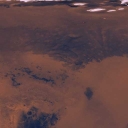 UTOLPIA PLANITIA
UTOLPIA PLANITIAA smooth plain on Mars situated northwest of the Elysium Planitia volcanoes and chosen as the landing site for Viking 2 in 1976. It is speculated that dust particles in the atmosphere pick up tiny bits of water. When it gets cold enough for carbon dioxide to solidify, some of it attaches to the dust and ice and it falls to the surface.
CYDONIA MENSAE
Cydonia Mensae is an albedo feature (region) on Mars. It lies in the planet's northern hemisphere in a transitional zone between the heavily-cratered regions to the south and relatively smooth plains to the North. Cydonia itself is covered in numerous mesas and may have been a coastal zone if planetologists are correct in believing that the northern plains were once ocean beds. One of the Cydonian mesas, situated at roughly 40.9 degrees North latitude and 9.45 degrees West longitude, took on the striking appearance of a human "face on Mars" in a photo taken by Viking 1 in 1976. Whilst generally held to be an optical illusion (pareidolia) - a result of lighting on topographical features, some people interpreted it as artificially created, evidence of a long-lost intelligent civilization of Mars. The so-called "face on Mars" no longer appeared so convincingly as a face, but as just another geographical feature on the red planet.
|
|
Sports on Mars
Mars is the perfect place for different kinds of extreme sport. The largest volcano and the deepest canyon of the Solar system, as well as the violet weather and temperature patterns make Mars one of the most interesting and exciting worlds for researching and tourism. The sports that can be practised on Mars are quite different than those on Earth. The main reason for this big difference is the gravity, which is smaller on the red planet. This fact causes a lot of new games and ideas for sport, such as the following some:
1.Sand Skiing
On the Earth we can skate over the water ice, because we put it under pressure - the superficial layer melts, becoming into water between the skates and the deeper layers. So we can freely slide. Thanks to the temporarily and fractionaly fusion of the crystals water ice it is possible on Earth to make snowballs. But all this can be realized only when is available special combination of temperature and pressure values for some stuff like the water on Earth, i.e. when the stuff has liquid physical condition. Neither for the water nor for the carbon dioxide there are such special conditions on Mars related to the temperature and the pressure. That is why the martian snow is dry and loose like a sand. Although it is impossibe to play ice-hokey or make snowballs the skiing over the sand dunes is already realized in some of the deserts on the Earth.
2.Broken Terrain Racing
Wrestling and tennis are nearly the only Earth game sports played on martian surface. But we are always looking for other sports to play. Every new tourist can create a sport of his own that he thinks people on Mars would play. An example for a succesful new idea is the Broken Terrain Racing. The number of players is unlimited, but the base has a hundred race-cars. The track is on a broken terrain which is very challenging and dangerous - the general reason are the thousands of rocks everywhere on the track. Only experienced drivers are free to explore the whole area. The finish target is marked with a 15 m tall flag. The winner gets the award of his own skills.
3.Gym, Jogging & more
People on Mars have to exercise, just like people on Earth, to keep themselves in good physical condition. In the Base Gym (it can be found in every station through the tours), people lift weights, do chin-ups, push-ups, and most anything else you would see in a gym on Earth.

